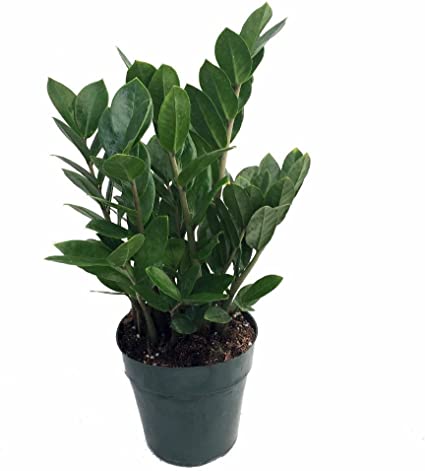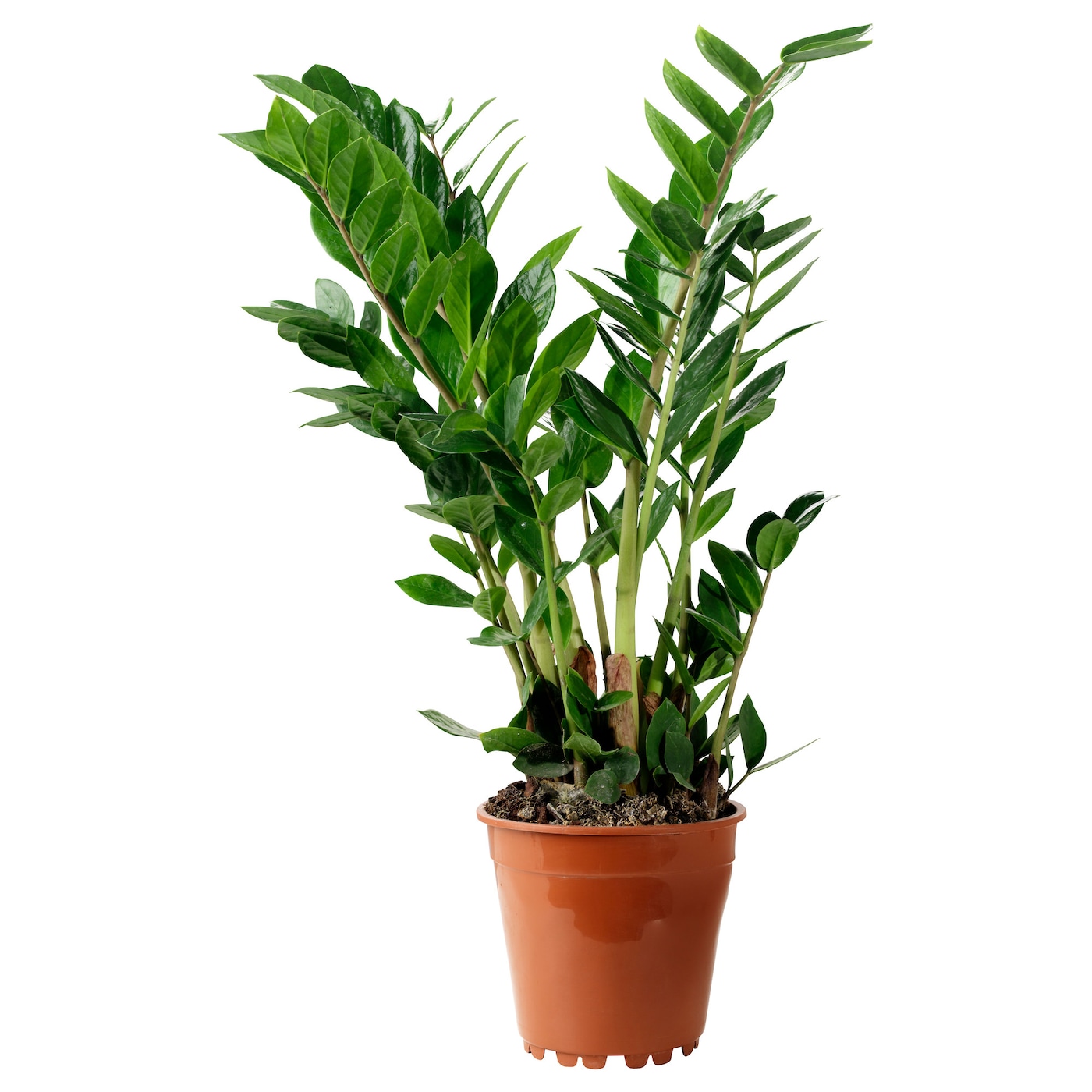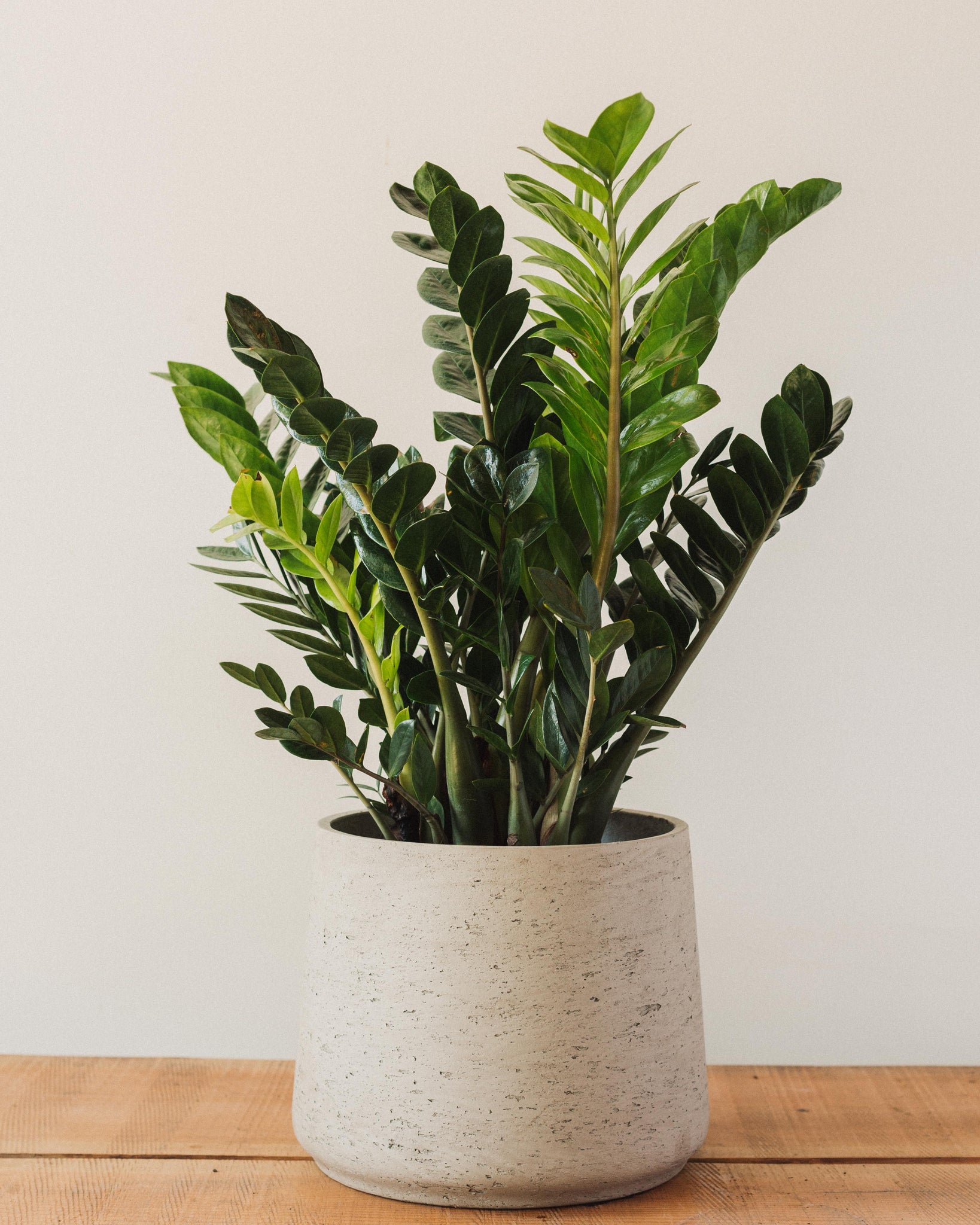
The plant we know as Zamioculcas is called Zamioculcas zamiifolia and is therefore often called simply ZZ plant. There is a big chance that you will come across this houseplant: it is immensely popular. The reason? It is very easy to care for. Of course, it remains a living plant that you have to maintain, but it generally requires little attention. All about the care of the Zamioculcas, and an answer to frequently asked questions, can be found here.
Table of Contents
Zamioculcas care
In English, the ZZ plant is also called the Eternity plant. “Eternity” means forever; the plant has this nickname because it could live forever. A plant only gets such a nickname if it is really a strong houseplant. Yet it remains a living plant that, no matter how strong, has specific wishes in terms of care. You can read about them here.
Location and light
The location determines the type and amount of light the Zamioculcas gets. Preferably put the plant in a place where it gets a lot of light, but no direct sunlight. This means:
- South-facing window: 3 to 4 meters away from the window
- A window facing west or east: 2 to 3 meters away from the window
- A north-facing window: May be placed directly near the window
The Zamioculcas gives you feedback on light. Does it get black spots? Then there is usually too much sunlight. A few black spots are normal, but if they become many, and the black spots really look like damage, then it is a sign of too much sunlight.
Another sign of too much light is very rapid growth and branches that start to droop. In that case, move the ZZ plant a little further away from the window.
A place in the full sun is less suitable, but neither is the dark. Every plant, including this one, needs sufficient light to grow well. You know the plant is too dark when it does not grow at all, even in spring and summer. So in that case she needs more light.
Watering Zamioculcas
These plants store water their their leaves, stems and roots. Did you know that the stems of the Zamioculcas consist of up to 95% water? There are studies where this plant can go up to four months without water. Even the Sanseveria could learn something from that! By the way, we would not recommend not watering this plant for four months. She may survive, but it’s not good for the plant.
Instead, water it when the soil has dried out. In the summer months this is usually within two weeks, in the winter usually within four weeks. Notice that the soil is still wet after this period? Then you have given too much water. Next time, give a little less water.
You can tell from the plant whether you are giving it too much or too little water. When yellow leaves appear on the Zamioculcas, it probably gets too much water. Especially the lower leaves will turn yellow. You can also see that the stem becomes brown and wrinkly. If you continue to give too much water, other problems such as mold formation will arise and eventually the Zamioculcas will die.
Too little watering is accompanied by other problems. You notice a lack of water first by the loss of leaves. If you see the Zamioculcas dropping leaves, check the soil. Has it been very dry for a long time? Then the loss of leaves is probably due to a shortage of water.
Temperature
The minimum temperature for the Zamioculcas is 15° C. This plant grows best at higher temperatures, up to a maximum of 26°C. Also avoid rapid temperature fluctuations, for example due to a radiator, draught or air conditioning.
Feeding the ZZ plant
This strong houseplant needs little nutrition. Only add nutrition during spring and summer. Always read the instructions on the packaging: plant food is often highly concentrated. A surplus of nutrition is harmful, so preferably give a little less than indicated. This advice applies to all strong houseplants such as the Elephant’s Foot.
How to prune Zamioculcas zamiifolia
Pruning is not an essential part of maintaining the Zamioculcas. Pruning is mainly about the appearance of the plant. In terms of health pruning is not necessary. For ornamental value you can remove the dry and yellow leaves. Please note that you cannot shorten the stems. However, you can choose to prune a stem completely. If you remove the longest stems you make the entire plant a little lower. The stems of the Zamioculcas can be cutted.=> Prefer a hanging plant? Then take a look at the Lipstick plant (Aeschynanthus) or the Grass lily (Chlorophytum)
When and how to repot
Repot the Zamioculcas every two years. Use a flowerpot that is about a quarter larger than the previous one. Really do not wait too long with repotting. The roots of the Zamioculcas are very strong. If you wait too long, and the pot becomes too small, the pot may burst due to the large root system.
When transplanting, always use fresh soil. Also, always provide holes in the bottom of the flower pot, so excess water can drain away. You can further ease this process of drainage by placing a layer of hydro grains on the bottom. This drainage is very important: it prevents root rot.
Which potting soil for the Zamioculcas
The Zz plant grows well in normal potting soil for houseplants. Often this potting soil contains nutrition for a number of months. Do not give extra plant nutrition in that period.
Zamioculcas species
Within the Zamioculcas plant family there is only one species: the Zamioculcas zamiifolia. This is in contrast to, for example, a Calathea with its dozens of species. So you can’t encounter multiple species of Zamioculcas, but you can encounter multiple cultivars. The most common are:
- Zamioculcas zamiifolia ‘Zenzi
- Zamioculcas zamiifolia ‘Raven’
- Zamioculcas zamiifolia ‘Super Nova
Buy Zamioculcas
You can buy the Zamioculcas in many places. The easiest is to order this indoor palm online. Then you can easily compare prices. The button below will take you to the current offer at Bol.com:

How big can the Zamioculcas get?
The Zamioculcas can grow to a height of about 1 meter. At this height the leaves can grow up to 15 centimeters long. The maximum height, however, strongly depends on the space in the pot and the care.
Is the Zamioculcas poisonous?
Yes: the Zamioculcas is poisonous to cats, dogs or other animals. It is also good to keep the plant away from a baby. There is a danger of pulling the plant over and breaking it. The sap can irritate and should absolutely not be ingested.
Can the Zamioculcas flower?
It can, but rarely happens as a houseplant. As a rule, a flower on the ZZ plant is actually a bad sign: then the plant is seriously neglected and is in danger of dying. This is a last resort of the plant to still be able to spread. Below in the picture you can see the flowering.
Bugs and diseases
A major advantage of the Zz plant is that it is quite resistant to lice and other critters. Also diseases are rare. You can make the plant even more resistant by taking good care of it. A healthy plant is less susceptible to bugs and diseases.
Can you put the Zamioculcas outside?
You can, but only in spring and summer. Autumn and winter are too cold. In any case, keep the plant out of the full midday sun, which is too hot.
The Zamioculcas does not produce new stems or leaves
Help, the plant is not growing anymore! Can’t see any new shoots emerging? This is not an immediate reason to panic. It is normal for the plant not to grow in the fall and winter. If still nothing happens in the course of spring, there is reason to investigate:
- Is the plant getting enough light?
- Isn’t the soil dry for too long?
- When did she last receive nutrition?
- Isn’t the pot already too small?

Yes, but the plant has small leaves. Therefore, you will not benefit very much from the air-purifying property. The more leaf area, the more air the plant can purify. For an air-purifying plant, look at a Banana plant, the beautiful Strelitzia or the sturdy Philodendron. These have much larger leaves and therefore can purify more air.
Should you water this plant?
You don’t have to, but you can. Spraying has the advantage that less dust remains on the leaves. Thus, spraying increases the ornamental value of the Zz plant.
Summary
| Botanical name | Zamioculcas zamiifolia |
| Also known as | Zamioculcas, ZZ plant, Caladium zamiaefolium, Zamioculcas loddigesii, Chamber palm |
| Origin | Zanzibar, Kenya and Madagascar |
| Maximum height | 1 meter |
| Demand for light | Much indirect light |
| Demand for water | Little |
FAQ
Is Zamioculcas an indoor plant?
The ZZ plant is an easy to grow and care for indoor plant that displays small glossy leaves on stems which can grow up to 3 ft long indoors. The zamioculcas zamiifolia (botanical name) grows well in low or bright lighting conditions and with frequent or much less frequent amounts of water.
What does ZZ plant symbolize?
Also nicknamed the “Eternity Plant” and the “Fortune Tree,” the ZZ brings growth and assistance wherever it lives. With their reputation for growing fast and maintaining a strong foundation with their thick branches, ZZ’s are said to block Sha chi, the most well-known form of negative energy.
How do you care for a ZZ plant indoors?
Water your ZZ Plant every 2-3 weeks, allowing the soil to dry out between waterings. Expect to water more often in brighter light and less often in lower light. Signs that it is thirsty include wilting, wrinkled leaves, and dry potting mix, while wet mix or yellowing and mushy leaves signal overwatering and root rot.
Is Zamioculcas a succulent?
ZZ plant is an easy-to-grow succulent houseplant in the Araceae (ariod) family native to Africa. The species name means with leaves like ZamiaZamiaThis plant has low severity poison characteristics. Zamia is a large genus of shrubs from tropical America with one species being native to southern USA. All the species produce leafy crowns of foliage that resemble palms or ferns and most branch heavily with age to produce attractive clumps.https://plants.ces.ncsu.edu › plants › zamiaZamia – North Carolina Extension Gardener Plant Toolbox which is an unrelated genus. It is one of the easiest to grow low maintenance houseplants and is seen frequently in commercial interiorscapes.
Why is ZZ plant so popular?
Adaptable in Nature. The reason why the ZZ plant gained so much popularity is that it’s probably the toughest plant out there. It does well in both high and low lighting conditions. So you can place it both indoors and outdoors, and it’ll do equally well.
